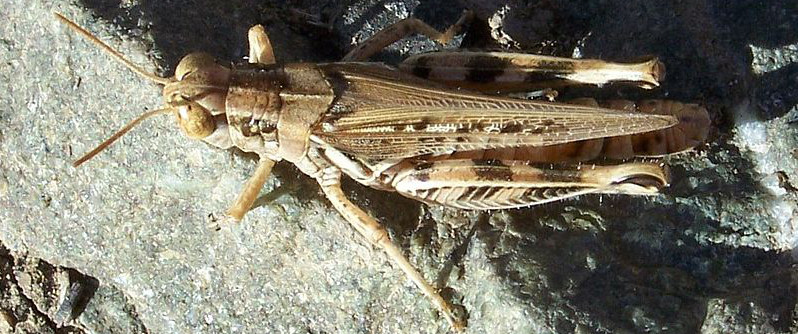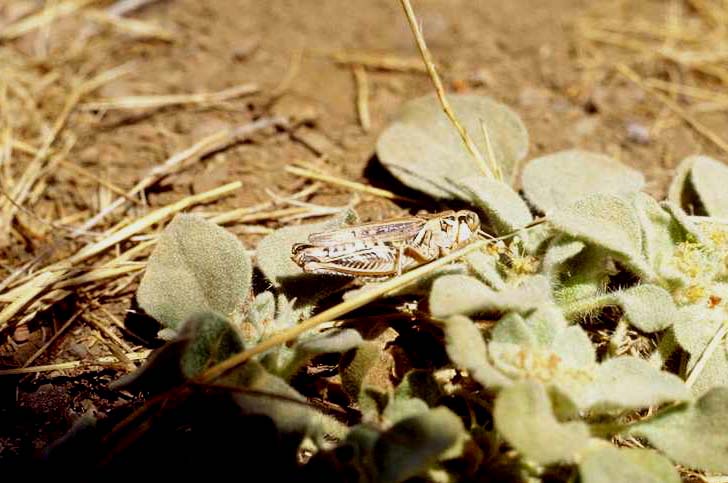
Form and Function
Grasshoppers may not be the easiest organisms to distinguish,
but the Melanoplus devastator has many identifying
characteristics that makes it easier for the average eye to
recognize. It is closely related to the M. sanguinipes
and as mentioned in the
habitat
section. They live in very different areas. Location has a
significant effect on how the organism grows and reacts to the
stimuli in its environment. It is a tell tale sign that the
M. devastator is the larger of the two species (Orr et
al. 1993). One of the evolutionary reasons why they
are larger is that the devastating grasshopper lives in a
typically warmer climate. As the temperature increases across
the different ranges of latitude the longer the grasshopper has
time to complete embryonic development before hatching (Dingle
and Mousseau 1993). The longer the embryo stays in the
development stages the larger that the organisms gets. The
Melanoplus devastator has a larger cercus and farcula than
its closest relative and is a distinguishing feature in the wild
and a good way to determine the sex of these grasshoppers is to
look at the cerci and fracula (Orr et al. 1993). The
same article states that the cerci are elongated and slender and
the farcula is long and extends in much greater lengths than the
M sanguinipes. Multiple studies have also shown that
even though the Melanoplus devastator has the larger
cercus and farcula, the actual width of its body is smaller than
that of the M. sanguinipes (Tatar et al.
1997).
The longer the embryo stays in the
development stages the larger that the organisms gets. The
Melanoplus devastator has a larger cercus and farcula than
its closest relative and is a distinguishing feature in the wild
and a good way to determine the sex of these grasshoppers is to
look at the cerci and fracula (Orr et al. 1993). The
same article states that the cerci are elongated and slender and
the farcula is long and extends in much greater lengths than the
M sanguinipes. Multiple studies have also shown that
even though the Melanoplus devastator has the larger
cercus and farcula, the actual width of its body is smaller than
that of the M. sanguinipes (Tatar et al.
1997).
The
Melanoplus devastator has a pale green and tan body and the
center of the abdomen is a pale greenish-yellow that mimics the
surrounding environment that it lives in (Pfadt 1994). This
color coordination with thier body and the surrounding
environment is to help protect themselves from potential
predators by blending in with the use of camouflage. Males are usually the easiest to
identify because they posses some of these distinguishing
characteristics. These grasshoppers also have long wings that
extended beyond the end of its body, making them a stealthy
flyer (Pfadt 1994). The same article talked about the tegmen and
how it is identifiable because of the black spots that cover its
surface. Along with that color pattern they also have blue or
sometimes red back hind legs, and the legs of the devastating
grasshopper tend to be enlarged and give the elongated look to
the grasshopper itself.
Temperature,
altitude, and latitude all play a role in the life of a
Melanoplus devastator and the way in how it reacts to the
environment and stimuli in the environment (Roff and Mousseau 2005). These
interactions led eventually to the evolutionary adaptions in
these animals to their habitat, like their coloration, the way
their body’s move and the overall shape of the body and limbs.
These differences can also help humans identify these organisms
and help in trying to distinguish different species apart from
one another. Essentially the form and function of an animal
shows the relationship that the organism has with the
environment and the impact that it has on reproduction, food, habitat, and
everyday activities.
Look back at its habitat Home Page Move on to Reproduction